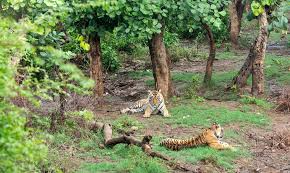Over 50 mines may benefit as Sariska’s Critical Tiger Habitat to be redrawn

Alwar, Rajasthan – June 23, 2025:
Authorities are planning to redraw the boundaries of Sariska’s Critical Tiger Habitat (CTH) in Rajasthan. This decision could affect over 50 mining operations that have faced restrictions for years. The move has sparked debates between conservation groups and the mining industry.
Why the Tiger Habitat Boundaries Are Changing
The Central Empowered Committee (CEC), formed under the Supreme Court, proposed the revision. According to their assessment, parts of the current CTH do not support tiger activity. At the same time, new areas outside the boundary have seen regular tiger movement.
Rajasthan’s Forest Department supports the change. Officials say they want the habitat to reflect current wildlife data. “We are protecting zones where tigers actually roam,” a forest officer said. “The goal is to make the reserve more effective, not smaller.”
This adjustment would remove areas with little ecological value. Meanwhile, it adds forest patches that help link tiger routes.
What It Means for Over 50 Mines
The new map could benefit more than 50 mines. Many of them extract marble, limestone, or copper. These mines have operated near or inside the current CTH. However, a 2023 Supreme Court order banned mining within one kilometre of the reserve.
If the new boundaries exclude some mining areas, those operations may resume legally. Mine owners and workers in Alwar district see this as a relief.
“Many of our leases are older than the tiger reserve itself,” said Kailash Meena, a spokesperson for the Alwar Mining Union. “We were shut down without fair reason. This change brings hope for our families.”
Conservationists Are Worried
Wildlife activists are alarmed. They believe the redrawing serves business interests more than environmental ones. According to them, even low-activity zones support the larger tiger ecosystem.
“This is not just a map change. It affects the future of our forests,” said Priya Sharma from the Sariska Watchdog Coalition. “Even small forest areas matter. They connect tiger corridors and protect gene diversity.”
Experts also worry about the risk of setting a national precedent. If Sariska’s CTH changes, other reserves may follow the same path under pressure from industries.
Legal and Approval Hurdles
The plan is not final yet. Several bodies must approve it, including the State Board for Wildlife and the National Board for Wildlife. The Supreme Court’s CEC will also review it.
Courts have been strict about mining near protected areas. Earlier this year, Rajasthan was told to appoint a nodal officer to monitor illegal mining near Sariska. This officer now submits regular reports to the court.
Advocate Vikas Choudhary, who handles environmental cases, commented on the matter. “Just redrawing boundaries does not bypass the law,” he said. “Activists can challenge the plan if it violates conservation rules.”
Villagers React with Mixed Feelings
Villages near Sariska remain divided. Some welcome the news, hoping it brings jobs back. Others fear it may hurt eco-tourism and the forest.
“Tourism feeds many families here,” said Sangeeta Devi, who runs a home-stay in Tehla village. “Mining may offer quick income, but tourism supports us long-term.”
Several locals feel caught between jobs and jungle. While some work in mines, others earn from wildlife tours or forest products.
What’s Next?
If the new CTH map is approved, many mines could reopen. This would bring economic activity back to the region. However, it could also lead to lasting environmental damage if not managed well.
Wildlife officials plan to complete the boundary changes by December 2025. Until then, the debate over Sariska’s future continues.
For now, the question remains: can India balance development and conservation in a fragile ecosystem?






